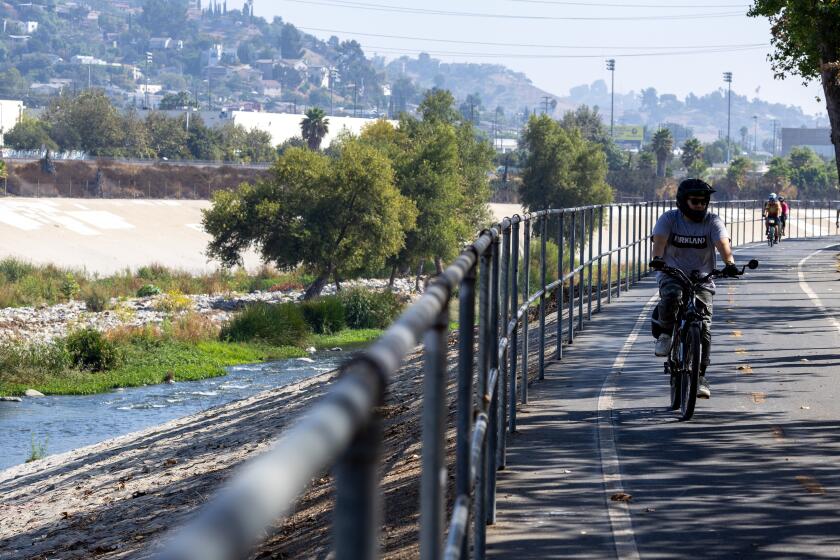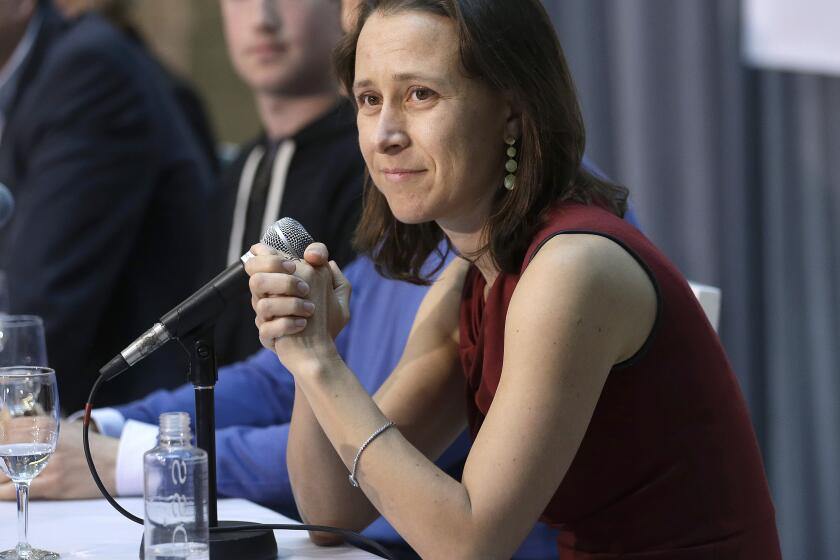Op-Ed: Metro is hemorrhaging riders. It needs to stop studying obvious fixes and start acting
L.A. Metro has a lot going for it. Its transit network is expansive and, compared with other U.S. cities, relatively cheap. You can travel across much of L.A. County for $1.75, making it affordable for the vast majority of residents. And it enjoys significant public backing. With the passage of Measure M in 2016, Angelenos overwhelmingly voted to spend billions to improve the system.
Unfortunately, it can also be a big pain to use.
Outside of rush hour, 20-minute waits for buses and trains are the norm. And since buses rarely have their own lanes, they get stuck in traffic, making arrival times erratic and smooth transfers a roll of the dice. Bus shelters and other creature comforts to help riders deal with the elements or long travel times are spotty at best. Worst of all are the safety concerns. A 2018 Metro survey revealed that 15% of bus riders and 21% of rail riders have experienced at least one incident of sexual harassment while using the system.
For those of us who ride Metro, it’s no surprise that the system has lost an estimated 22% percent of its bus ridership over the last five years.
What if — radical concept here — instead of focusing on luring new riders, Metro improves the system for those who use it now.
Metro says it is taking these losses seriously. For the last year it has been working on what it calls the NextGen Bus Study. Due at the end of 2019, this study will propose new route and schedule changes, which should help make L.A.’s most trafficked bus lines more efficient.
And that’s all well and good. But frankly, those of us who actually use the system are tired of waiting. There are any number of things that Metro can do now to make our rides better.
The most obvious fix is all-door boarding on buses. All-door boarding is exactly what it sounds like; Riders are allowed to board the bus and pay at whichever door they please rather than everyone having to board through the front door. It’s a small change, but it’s a best practice for transit agencies around the globe — and it can make a big difference in travel times.
In 2012, San Francisco’s transit agency Muni implemented all-door boarding system-wide. After two years of all-door service, time spent at bus stops fell by 37%. This was a big win for transit riders, as bus stops account for between 9% and 26% of total travel time.
In 2015, Metro did an all-door boarding study on its crowded 720 Wilshire line. Amid flagging bus ridership, why they felt they needed to study, rather than just do something, is perplexing. But OK, they did their study. Then, a year later in 2016, they did another study on the Silver Line. Both of these studies told them what they already should have known: All-door-boarding improves arrival times.
Naturally, the next step was to implement all-door boarding on the two lines that were studied, which Metro did. In 2018. It took three years to roll out basic changes to two bus lines.
So what about the rest of the system? Over the last year, almost all my local bus trips have been on buses moving toward having the necessary infrastructure for all-door boarding. Some buses already have working TAP readers at each door. (Great!) Some have working TAP readers at each door, but the bus driver won’t open all the doors. (C’mon!) Some have plastic bags over the TAP readers. (Classy!) Some have stickers by the doors that said “TAP” but no reader. (Huh?)
This indecisive, spotty and generally incompetent approach to an obviously good idea is confusing and alienating riders even further. Why not just announce a system-wide roll-out and get it done? Muni transformed its whole system in six months.
Enter the Fray: First takes on the news of the minute from L.A. Times Opinion »
And there are other things Metro can stop studying and implement right away. How about replacing our inexplicable cloth seats with vinyl? Cloth seats can hide bed bugs, lice and other disgusting surprises. They’re also more expensive and labor-intensive to maintain than vinyl seats. Yet Metro continues to purchase vehicles with cloth seats while it conducts a test rollout of vinyl.
Yes, these upgrades cost money. But Angelenos voted to tax ourselves billions for Measure M because we want a better transit system. And while multibillion-dollar new rail lines take time, planning and significant regional cooperation, rider experience enhancements are fully under Metro’s control.
Most Metro customers live below the poverty line and can’t afford a car. Though Metro talks about attracting “choice” riders — people who own a car, yet choose to ride transit — a report last year from UCLA shows L.A. transit riders are increasingly choosing to drive as soon as they can afford to. Fully 79% of former Metro riders now primarily drive alone.
What if — radical concept here — instead of focusing on luring new riders, Metro improves the system for those who use it now. If it can entice current riders to stay, former riders might return and new riders might be more inclined to give up their cars. To accomplish that, however, Metro needs to stop studying industry best practices and get them done.
Mehmet Berker is an advisory board member for Los Angeles Walks and a transit-dependent Angeleno.
More to Read
A cure for the common opinion
Get thought-provoking perspectives with our weekly newsletter.
You may occasionally receive promotional content from the Los Angeles Times.










